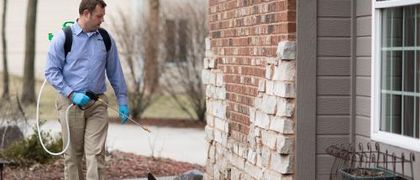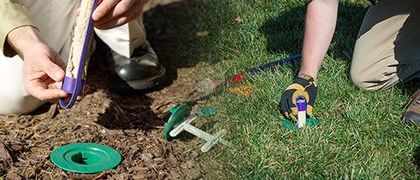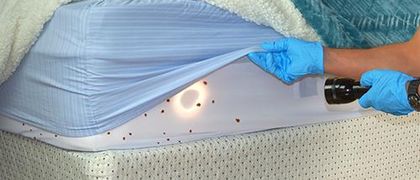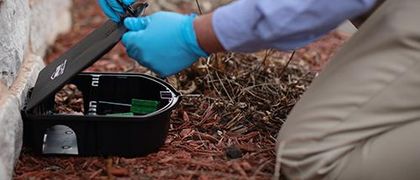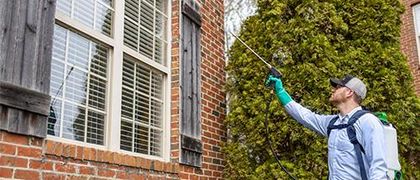Carpenter Ants in Nebraska: Facts, Treatment, & Prevention
Carpenter ants are a serious concern for Nebraska homeowners—especially in the spring and summer when they ramp up activity in search of food and nesting sites. These wood-hollowing ants don’t eat wood like termites do, but they’re more than capable of weakening structural wood over time. And here in our state, that’s not uncommon.
Let’s walk through what they look like, where they’re hiding, and how you can get rid of them and keep them out.
Key Takeaways
- Carpenter ants in Nebraska are big black ants with rounded thoraxes and are often confused with flying termites.
- The real damage happens when carpenter ants tunnel through wood, hide in wall voids, and feed on honeydew from aphids.
- Getting rid of carpenter ants takes inspection, baits, dusting, and sealing cracks around gutters, tree branches, and foam insulation.
- Preventing carpenter ants means fixing leaks, removing stumps, trimming trees, sealing entry points, and setting up regular pest control.
What Do Carpenter Ants Look Like?
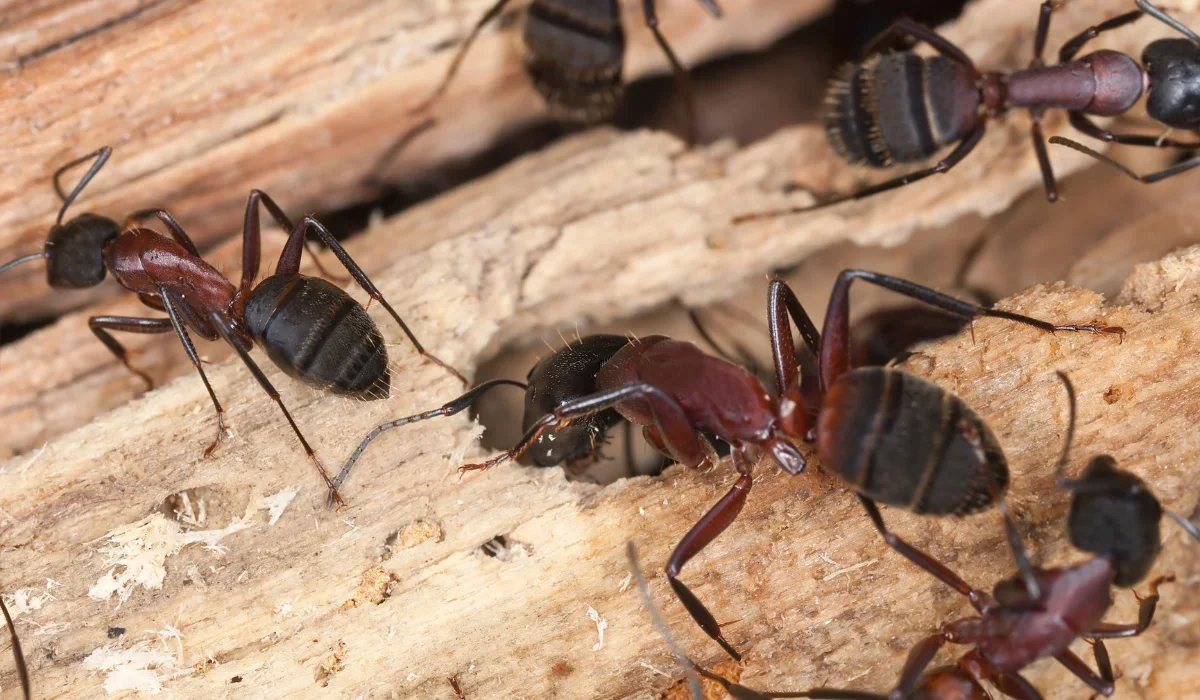
The most common ant species you'll find in Nebraska is the black carpenter ant (Camponotus pennsylvanicus), although Camponotus sayi is also found in wooded areas.
Carpenter ant workers range from ¼ to ½ inch long, with a large, rounded thorax and elbowed antennae. Swarmers—winged reproductives—can be even bigger and are often mistaken for termites.
Why Carpenter Ants Are a Problem
Carpenter ants don’t eat wood, but they do chew through it to make their nests. Over time, that can do some real damage—especially to beams, joists, and other parts of your home already weakened by moisture.
Here’s what makes a carpenter ant problem more serious than it might look at first:
- They’re sneaky. Most carpenter ant workers are nocturnal, so you might not notice them until the colony is well-established.
- They tunnel through structural wood. That can lead to costly repairs if they’re left alone.
- They leave behind clues. Look for rustling in walls, foraging workers, and piles of sawdust near baseboards or windows.
- They’re farmers, too. Carpenter ants farm aphids for their honeydew on nearby plants, which gives them a steady food source close to your home.
- They multiply fast. Inside the colony, workers feed and care for larvae and pupae, while reproductives and the carpenter ant queen focus on growing the colony.
How the Pros Get Rid of Carpenter Ants
Getting rid of carpenter ants takes more than just knocking out the ones you see. If you want real results, you’ve got to go after the whole colony—especially the ones you can’t see.
At Miller Pest & Termite, here’s how we handle carpenter ant infestations the right way:
Thorough Inspection and Colony Mapping
We start by identifying the specific ant species, tracing their movement patterns, and locating both the parent colony and any satellite colonies. A careful inspection often reveals hidden ant nests in tree stumps, wall voids, or foam insulation.
This step is essential because every nesting site needs to be addressed for long-term success.
High-Performance Baits
Professional-grade baits are ideal for carpenter ant control. These baits attract foraging workers who then carry the active ingredient back to the colony, affecting the larvae, reproductives, and queen.
Unlike over-the-counter sprays, which might only kill a few ants on contact, baiting targets the entire colony over time.
Targeted Dusting of Void Spaces
When ants are hiding in wall voids or areas like behind kitchen cabinets, we use targeted dust treatments that penetrate deep into crevices.
These dusts settle into hard-to-reach nesting sites, providing long-term control and reducing the need for repeated surface treatments.
Exterior Barrier and Entry Point Treatment
We apply treatments around parts of the structure where ants are entering—like baseboards, gutters, and cracks near windows or doors. We also inspect and treat tree branches or landscape timbers that touch the home.
Our approach ensures full coverage from the ground up to the roofline.
Long-Term Monitoring and Adjustments
Even after initial pest management and treatment, we keep an eye on activity to make sure no new colonies pop up.
We provide practical advice, like working with an arborist to remove infested trees or advising on how to store firewood properly, to reduce the risk of re-infestation.
How to Stop Infestations Before They Start
If you've had carpenter ants before, you know they’re not the kind of problem that goes away on its own. And if you haven’t, consider yourself lucky.
Either way, there are a few simple things homeowners in Nebraska can do to make their homes less inviting to these wood-hollowing pests:
Fix Moisture Problems Quickly
Wet wood attracts carpenter ants.
Whether it’s a leaky roof, water-damaged parts of the structure, backed-up gutters, or poor drainage around the foundation, excess moisture invites trouble. Prompt repairs can prevent infestations before they start.
Eliminate Nesting Sites Around the Home
Carpenter ants often nest in stumps, dead trees, and decaying wood piles.
Remove any old wood, store firewood away from the home, and don’t let leaf litter or dead branches pile up around porches or sheds.
Trim Back Tree Branches
Tree limbs that touch your roof or siding act as highways for foraging ants.
Trimming back these branches makes it harder for ants to find their way in from nearby vegetation, dead insects, or aphid-covered plants.
Seal Crevices and Entry Points
Inspect your home for cracks, gaps, and other crevices—especially around windows, doors, and utility lines.
Sealing these off not only helps prevent carpenter ant infestations but also keeps out wasps and other pests.
Schedule Preventive Pest Control
Routine pest control is your best line of defense. Our MillerGuard and MillerGuardPlus plans offer year-round protection, keeping carpenter ants, termites, and more than 30 other pests at bay with targeted, ongoing treatments.
Call us today to protect your home from structural damage and growing carpenter ant colonies.
Get Help Now!

